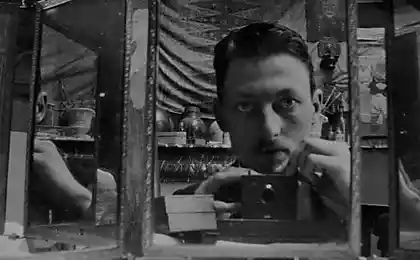1062
Factors perception
1. Feeds can change your mood
Because of its popularity, Facebook is not without scandals. Last occurred because the details of the experiment, which was conducted on 700,000 people for one week of 2012. Services newsletters started to manipulate and demonstrated in the news only positive, or vice versa - only negative news. This was done in order to assess the mood of the people for change in their status in the social network. And it worked: the change in status showed changes in the emotional state, which completely match the type exhibited by the news. They called it "emotional infection." And all this confirms something frightening.
Research shows that people do not even have to be in close proximity to a person with a bad mood to "soak" in over his negative emotions. Negativity can "pick up", just looking at the monitor. Also, people do not necessarily consist of a personal emotional connection with the "negative" person to there "emotional contagion." So do not be surprised that after the publication of the results of the study had serious anxiety, and now this phenomenon is studied more closely, organizations such as the Office of the Information Commissioner in Dublin. Also, there are people who question the ethics of such research, stating that they are not other than the psychological manipulation. If someone does all this seem suspicious enough, adding that Facebook users were not even aware of the fact that all their emotions and whims via feeds managed by someone else.

2. The facts submitted in the form of stories, much more efficient
Let's say you're sitting at a meeting of sales representatives and tell you a great story about how your boss had a very first good deal of his career. Also, you give it a list of transactions which reflects the exact statistics, facts and figures. Which of these do you remember best? Even if the list will contain exactly the same facts as narrated in the earlier history, more details you can remember it from history and not from the list. Therefore stories are incredibly powerful thing, and there's some interesting research, explaining why we consider them more efficient way of getting information.
When we look at the list in our brain are activated by two zones: a zone of Wernicke's and Broca's area. And all this, what happens when scrolling through lists. A good story will activate a number of different areas of the brain, from the areas responsible for the interpretation of the speech to the areas that control our sensory perception. In addition, the history of doing what no one can do any list: it establishes a relationship with the narrator. And this relationship is of great importance when it comes to storing information presented in the story. Moreover, the listener himself becomes part of the story. Instead of dry facts of statistics he sees the characteristic signs, and he really wants to know what this is all over.
This desire to know what's next, has another interesting effect: it reduces the level of critical thinking. We treat less critical to the information supplied in the form of stories, we assume that there may be present a certain amount of fiction in order to make it more interesting. We disable their skepticism, without even realizing it. If we are given a bunch of dry facts, we are left with nothing, and we have to look for ways to entertain themselves "bored" part of our brain. Seeing this power of stories, some researchers put forward the idea that fiction could be much more effective to change our views than the huge dump of scientific data.

3. Messages sent on a subconscious level, really work
In 1950, a man named James Vikeri was the first who started experimenting with the transmission of messages on a subconscious level. It periodically showed the inscription «Coca-Cola» during the showing of films, and does so in several theaters. He claimed that this works fine, and that the sale of the beverage in the cinema have increased significantly. However, science has long doubted about the effectiveness of this method of transmitting messages. But then, scientists from the research organization of the Netherlands proved that despite the fact that the results of the "experiment" Vikeri ultimately proved to be a fake, sending messages on a subconscious level and actually works.
In studies of Dutch scientists participated volunteers who "treated" by passing their subliminal messages "drink" and "thirst." Results of the study demonstrated that subliminal messaging is possible, but in order for this to work, you need a number of additional conditions. For example, a person must receive some nice rewards for taking subliminal messages, a person in the course of the experiment should be a certain mental attitude, and in addition, there must be a strong psychological association between drink, and be rewarded.

4. We are programmed to be gullible, especially if we are smart
We know it looks like an obvious contradiction. But how many times have we heard about the most intelligent strata of the population, which are free, "were" the obvious scam? Today we have amazing credulity of those who have posted a lot of money, believed written in the "Nigerian letters" (known form of online fraud). However, psychologists believe that we can not believe the hype. In fact, what we are smarter, so we are gullible. And there are many methods of fraud that use this gap in our system of self-defense.
At the heart of this often lies one simple thing: smarter than we are, the less we tend to think that we can be fooled. We sincerely believe that we can recognize cheating per kilometer, and this confidence means that we are ready to ignore the obvious. There is one more thing: we are literally "programmed" to ensure that trusted sources that have always been considered reliable. We tend to trust people who carry the title of "Doctor", "Professor", and so on. D.
There is also an assumption that there are different types of intelligence. Intelligence, which allows a person to build a successful career, seriously differs from rogue intelligence. According to the psychologist Stephen Greenspan intelligence can change if it comes under a lot of pressure of society, and that it has long been a feature used in many fraudulent schemes.

5. One fonts we believe more than others
The font Comic Sans. The mere mention of it is enough to conjure up a postcard with an invitation to a party on the occasion of the birth of a child, or any advertisement of the nearest kindergarten. This font is not used in academic journals or in reputable newspapers, and there is a certain reason (besides aesthetics). In newspaper reports, essays, or in serious blog is generally used a font, which we believe.
In 2012, the columnist for the «New York Times» Errol Morris conducted an experiment. He took a passage from a book, describing a global catastrophe on Earth, and read it to the people. Then he asked how many people believe in the likelihood of such events on the planet. The survey was conducted by means of special profiles, each of which was published one of six random font: Trebuchet, Computer Modern, Baskerville, Georgia, Comic Sans, and Helvetica. By the end of the test period, the poll took place 45524 person. Numbers and data were different, but in the end turned out to be the font Baskerville advantage of 1, 5%. People who filled out a questionnaire written these letters, are more likely to agree with the probability of global catastrophe. The difference in the 1, 5% may not seem too big, but this figure could rise when it goes on the form of sales, or about the forthcoming elections. Among psychologists who analyzed the results of the study were David Dunning of the University of Cornwell. He believes that this is because people are more inclined to believe that looks official, and they are unconsciously processed this information with great care.

6. The probability of committing crimes you mentioned, if you're in a bad neighborhood
No matter how high your morals, there is a certain environment, under the influence of which you can start to make not too noble deeds. All this is called "broken windows theory". It was created by psychologists James Wilson and George Kelling. This theory states that the poorer the region, the more it's going on lawlessness. People in these areas perceive crime as a matter of course, and a lot of people who find themselves in such places are beginning to think that break the law here - quite acceptable. Experiments conducted in the Netherlands, confirmed this theory by showing that people are much more willing to steal money from mailboxes in disadvantaged areas. Other studies were performed by a psychologist from Stanford, near Palo Alto (CA), and in the Bronx (New York), and they also confirmed the theory. In these areas were left unattended vehicles. If the car was in good condition, it has not been touched. If the machine had a tacky appearance - its "stripped" literally within days. Moreover, a good car and destroyed in a few hours, and that it happened only once it was enough to hit him with a sledgehammer.

7. The size of a plate influences how much we eat
This is called "illusion Delbofa," and it is well known since 1865 year. The principle of its action is most clearly seen when we put food in a dish in catering establishments with self-service. Take two portions of equal size. One place on a large plate, the second on a small plate. Serve on a small plate will appear larger. When the research was conducted, it was found that those who give large plates in the middle to put 13% more food than those who give small plates. Roughly the same thing happens when we pour drinks. Pour yourself a drink in a small portion of the glass, and then try to pour the same amount of booze in a large glass. It will be very difficult to do, because the brain is very difficult to overcome the illusion associated with the size of glasses. Also note that here adds additional challenge: the brain is difficult to compare the vertical dimensions. Because of this, even the most experienced bartenders often think in a narrow and tall glass contains more liquid than it actually is. Interestingly, the size of the plates in the United States in recent years has increased by an average of 25%, and that is exactly coincided with progressive obesity epidemic.

8. Colors can change everything
Interior Decorators say that we are supposed to select the interior colors depending on what emotions we want to call with it. But there is something else. According to an article in the magazine «Forbes», warm colors such as red, and different shades of brown, can make a person feel warm. While cool colors such as blue, can make people feel cold. In fact, this means that you can save to pay for heating. Colors may also cause the above illusion Delbofa. When the plate has the same color as the food, you eat more.
Even more powerful effect on people's behavior has a light color. In 2000, in Glasgow, in Scotland, have replaced conventional street lights in the lights emitting a blue light, as is traditionally believed that this color has a calming effect. According to official reports, in areas with blue light the crime rate dropped significantly. In Japan, we have decided to follow suit. On reducing the level of crime reported by 9% after the blue lights were installed in the city of Nara. And later, a Japanese railway companies established blue lights on a railway platform, which was notorious for the fact that with it people often thrown under a train. The number of suicide attempts decreased significantly after that.

9. Advertising works even when we think that it is not
Of course advertising works: companies would not have to spend huge sums of money it if it were not so. Furthermore, there know which advertisements work best. That is why we see so many advertising messages that are seemingly unrelated to the advertised product.
The George Washington University and the University of California study was conducted. Volunteers give advertisements, which contained the true facts about the product. Another part of the test subjects were given ad, which is dominated by the image, cause positive emotions, and not directly related to the subject of advertising. After it analyzed the brain activity of subjects. It was found that the electrical activity of the brain is much higher if one considers the image is filled with fun images, regardless of whether they are related to selling a product or not. Images that cause positive feelings, cause a greater response in the minds of the target audience.
And yet advertising is designed to operate even when you use fast. When digital video recorders were invented originally thought that commercials have now lost their effectiveness because people will simply their "squander". However, research conducted «Harvard Business Review» have demonstrated that it is not. At that moment, when you think that the "rewind" advertising, you are still under its influence. By enabling fast forward, you will have to constantly look at the screen to know when to stop it. This means that you pay more attention to advertising more than you would like.

10. Some people are physically unable to resist pressure from others
Pressure from others often considered bad phenomenon than good. For example, "push" each other can be good, kind people, to learn something from each other, explore new ideas, or to engage in some hobby. If the pressure is seen in a bad context, here we are reminded of the people, encouraging their friends to try new drugs or begin shoplifting.
At some point, we can begin to think that others will be able to resist the pressure, but such thoughts - the same pressure that we just do not realize. It turns out that the pressure treated a separate area of the brain, the one that is responsible for the pleasure derived from the promotion. The Temple University conducted a study of the brain activity of teenagers who know what their friends are watching how they perform acts for which they may be punished. It is clearly seen that the act of violation of the law excites the pleasure centers in the brain. Watching from the teenagers became a kind of "trigger" to start the fun. From this it follows that when teenagers are aware that they are being observed, their behavior drastically changes, regardless of whether they are aware of it or not.

Source: www.publy.ru
Because of its popularity, Facebook is not without scandals. Last occurred because the details of the experiment, which was conducted on 700,000 people for one week of 2012. Services newsletters started to manipulate and demonstrated in the news only positive, or vice versa - only negative news. This was done in order to assess the mood of the people for change in their status in the social network. And it worked: the change in status showed changes in the emotional state, which completely match the type exhibited by the news. They called it "emotional infection." And all this confirms something frightening.
Research shows that people do not even have to be in close proximity to a person with a bad mood to "soak" in over his negative emotions. Negativity can "pick up", just looking at the monitor. Also, people do not necessarily consist of a personal emotional connection with the "negative" person to there "emotional contagion." So do not be surprised that after the publication of the results of the study had serious anxiety, and now this phenomenon is studied more closely, organizations such as the Office of the Information Commissioner in Dublin. Also, there are people who question the ethics of such research, stating that they are not other than the psychological manipulation. If someone does all this seem suspicious enough, adding that Facebook users were not even aware of the fact that all their emotions and whims via feeds managed by someone else.

2. The facts submitted in the form of stories, much more efficient
Let's say you're sitting at a meeting of sales representatives and tell you a great story about how your boss had a very first good deal of his career. Also, you give it a list of transactions which reflects the exact statistics, facts and figures. Which of these do you remember best? Even if the list will contain exactly the same facts as narrated in the earlier history, more details you can remember it from history and not from the list. Therefore stories are incredibly powerful thing, and there's some interesting research, explaining why we consider them more efficient way of getting information.
When we look at the list in our brain are activated by two zones: a zone of Wernicke's and Broca's area. And all this, what happens when scrolling through lists. A good story will activate a number of different areas of the brain, from the areas responsible for the interpretation of the speech to the areas that control our sensory perception. In addition, the history of doing what no one can do any list: it establishes a relationship with the narrator. And this relationship is of great importance when it comes to storing information presented in the story. Moreover, the listener himself becomes part of the story. Instead of dry facts of statistics he sees the characteristic signs, and he really wants to know what this is all over.
This desire to know what's next, has another interesting effect: it reduces the level of critical thinking. We treat less critical to the information supplied in the form of stories, we assume that there may be present a certain amount of fiction in order to make it more interesting. We disable their skepticism, without even realizing it. If we are given a bunch of dry facts, we are left with nothing, and we have to look for ways to entertain themselves "bored" part of our brain. Seeing this power of stories, some researchers put forward the idea that fiction could be much more effective to change our views than the huge dump of scientific data.

3. Messages sent on a subconscious level, really work
In 1950, a man named James Vikeri was the first who started experimenting with the transmission of messages on a subconscious level. It periodically showed the inscription «Coca-Cola» during the showing of films, and does so in several theaters. He claimed that this works fine, and that the sale of the beverage in the cinema have increased significantly. However, science has long doubted about the effectiveness of this method of transmitting messages. But then, scientists from the research organization of the Netherlands proved that despite the fact that the results of the "experiment" Vikeri ultimately proved to be a fake, sending messages on a subconscious level and actually works.
In studies of Dutch scientists participated volunteers who "treated" by passing their subliminal messages "drink" and "thirst." Results of the study demonstrated that subliminal messaging is possible, but in order for this to work, you need a number of additional conditions. For example, a person must receive some nice rewards for taking subliminal messages, a person in the course of the experiment should be a certain mental attitude, and in addition, there must be a strong psychological association between drink, and be rewarded.

4. We are programmed to be gullible, especially if we are smart
We know it looks like an obvious contradiction. But how many times have we heard about the most intelligent strata of the population, which are free, "were" the obvious scam? Today we have amazing credulity of those who have posted a lot of money, believed written in the "Nigerian letters" (known form of online fraud). However, psychologists believe that we can not believe the hype. In fact, what we are smarter, so we are gullible. And there are many methods of fraud that use this gap in our system of self-defense.
At the heart of this often lies one simple thing: smarter than we are, the less we tend to think that we can be fooled. We sincerely believe that we can recognize cheating per kilometer, and this confidence means that we are ready to ignore the obvious. There is one more thing: we are literally "programmed" to ensure that trusted sources that have always been considered reliable. We tend to trust people who carry the title of "Doctor", "Professor", and so on. D.
There is also an assumption that there are different types of intelligence. Intelligence, which allows a person to build a successful career, seriously differs from rogue intelligence. According to the psychologist Stephen Greenspan intelligence can change if it comes under a lot of pressure of society, and that it has long been a feature used in many fraudulent schemes.

5. One fonts we believe more than others
The font Comic Sans. The mere mention of it is enough to conjure up a postcard with an invitation to a party on the occasion of the birth of a child, or any advertisement of the nearest kindergarten. This font is not used in academic journals or in reputable newspapers, and there is a certain reason (besides aesthetics). In newspaper reports, essays, or in serious blog is generally used a font, which we believe.
In 2012, the columnist for the «New York Times» Errol Morris conducted an experiment. He took a passage from a book, describing a global catastrophe on Earth, and read it to the people. Then he asked how many people believe in the likelihood of such events on the planet. The survey was conducted by means of special profiles, each of which was published one of six random font: Trebuchet, Computer Modern, Baskerville, Georgia, Comic Sans, and Helvetica. By the end of the test period, the poll took place 45524 person. Numbers and data were different, but in the end turned out to be the font Baskerville advantage of 1, 5%. People who filled out a questionnaire written these letters, are more likely to agree with the probability of global catastrophe. The difference in the 1, 5% may not seem too big, but this figure could rise when it goes on the form of sales, or about the forthcoming elections. Among psychologists who analyzed the results of the study were David Dunning of the University of Cornwell. He believes that this is because people are more inclined to believe that looks official, and they are unconsciously processed this information with great care.

6. The probability of committing crimes you mentioned, if you're in a bad neighborhood
No matter how high your morals, there is a certain environment, under the influence of which you can start to make not too noble deeds. All this is called "broken windows theory". It was created by psychologists James Wilson and George Kelling. This theory states that the poorer the region, the more it's going on lawlessness. People in these areas perceive crime as a matter of course, and a lot of people who find themselves in such places are beginning to think that break the law here - quite acceptable. Experiments conducted in the Netherlands, confirmed this theory by showing that people are much more willing to steal money from mailboxes in disadvantaged areas. Other studies were performed by a psychologist from Stanford, near Palo Alto (CA), and in the Bronx (New York), and they also confirmed the theory. In these areas were left unattended vehicles. If the car was in good condition, it has not been touched. If the machine had a tacky appearance - its "stripped" literally within days. Moreover, a good car and destroyed in a few hours, and that it happened only once it was enough to hit him with a sledgehammer.

7. The size of a plate influences how much we eat
This is called "illusion Delbofa," and it is well known since 1865 year. The principle of its action is most clearly seen when we put food in a dish in catering establishments with self-service. Take two portions of equal size. One place on a large plate, the second on a small plate. Serve on a small plate will appear larger. When the research was conducted, it was found that those who give large plates in the middle to put 13% more food than those who give small plates. Roughly the same thing happens when we pour drinks. Pour yourself a drink in a small portion of the glass, and then try to pour the same amount of booze in a large glass. It will be very difficult to do, because the brain is very difficult to overcome the illusion associated with the size of glasses. Also note that here adds additional challenge: the brain is difficult to compare the vertical dimensions. Because of this, even the most experienced bartenders often think in a narrow and tall glass contains more liquid than it actually is. Interestingly, the size of the plates in the United States in recent years has increased by an average of 25%, and that is exactly coincided with progressive obesity epidemic.

8. Colors can change everything
Interior Decorators say that we are supposed to select the interior colors depending on what emotions we want to call with it. But there is something else. According to an article in the magazine «Forbes», warm colors such as red, and different shades of brown, can make a person feel warm. While cool colors such as blue, can make people feel cold. In fact, this means that you can save to pay for heating. Colors may also cause the above illusion Delbofa. When the plate has the same color as the food, you eat more.
Even more powerful effect on people's behavior has a light color. In 2000, in Glasgow, in Scotland, have replaced conventional street lights in the lights emitting a blue light, as is traditionally believed that this color has a calming effect. According to official reports, in areas with blue light the crime rate dropped significantly. In Japan, we have decided to follow suit. On reducing the level of crime reported by 9% after the blue lights were installed in the city of Nara. And later, a Japanese railway companies established blue lights on a railway platform, which was notorious for the fact that with it people often thrown under a train. The number of suicide attempts decreased significantly after that.

9. Advertising works even when we think that it is not
Of course advertising works: companies would not have to spend huge sums of money it if it were not so. Furthermore, there know which advertisements work best. That is why we see so many advertising messages that are seemingly unrelated to the advertised product.
The George Washington University and the University of California study was conducted. Volunteers give advertisements, which contained the true facts about the product. Another part of the test subjects were given ad, which is dominated by the image, cause positive emotions, and not directly related to the subject of advertising. After it analyzed the brain activity of subjects. It was found that the electrical activity of the brain is much higher if one considers the image is filled with fun images, regardless of whether they are related to selling a product or not. Images that cause positive feelings, cause a greater response in the minds of the target audience.
And yet advertising is designed to operate even when you use fast. When digital video recorders were invented originally thought that commercials have now lost their effectiveness because people will simply their "squander". However, research conducted «Harvard Business Review» have demonstrated that it is not. At that moment, when you think that the "rewind" advertising, you are still under its influence. By enabling fast forward, you will have to constantly look at the screen to know when to stop it. This means that you pay more attention to advertising more than you would like.

10. Some people are physically unable to resist pressure from others
Pressure from others often considered bad phenomenon than good. For example, "push" each other can be good, kind people, to learn something from each other, explore new ideas, or to engage in some hobby. If the pressure is seen in a bad context, here we are reminded of the people, encouraging their friends to try new drugs or begin shoplifting.
At some point, we can begin to think that others will be able to resist the pressure, but such thoughts - the same pressure that we just do not realize. It turns out that the pressure treated a separate area of the brain, the one that is responsible for the pleasure derived from the promotion. The Temple University conducted a study of the brain activity of teenagers who know what their friends are watching how they perform acts for which they may be punished. It is clearly seen that the act of violation of the law excites the pleasure centers in the brain. Watching from the teenagers became a kind of "trigger" to start the fun. From this it follows that when teenagers are aware that they are being observed, their behavior drastically changes, regardless of whether they are aware of it or not.

Source: www.publy.ru























